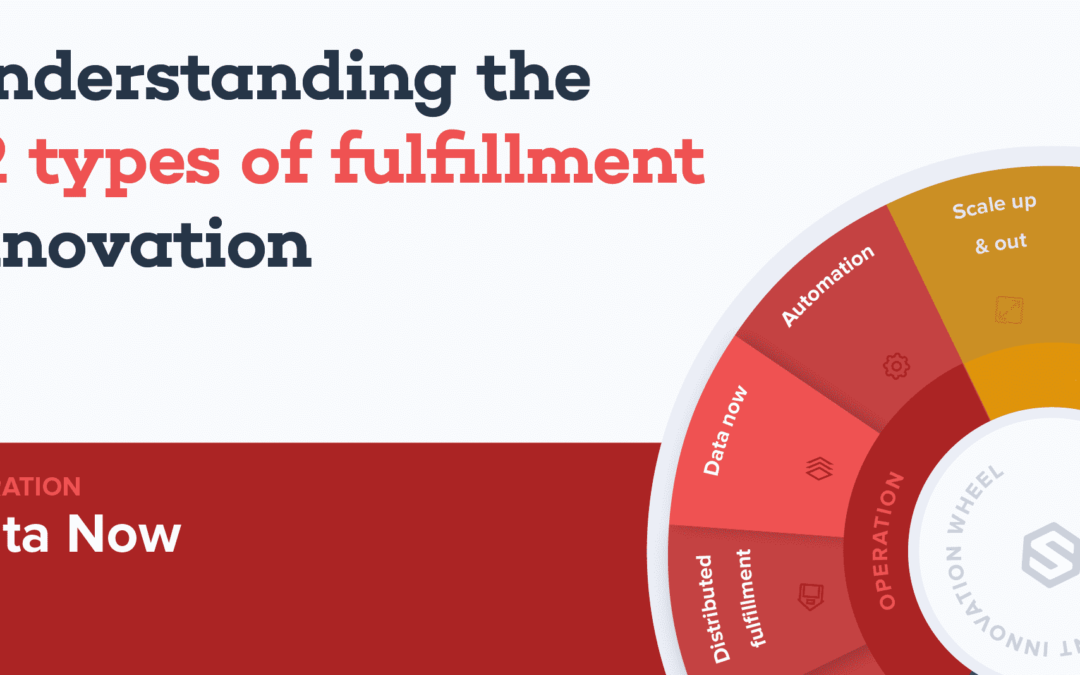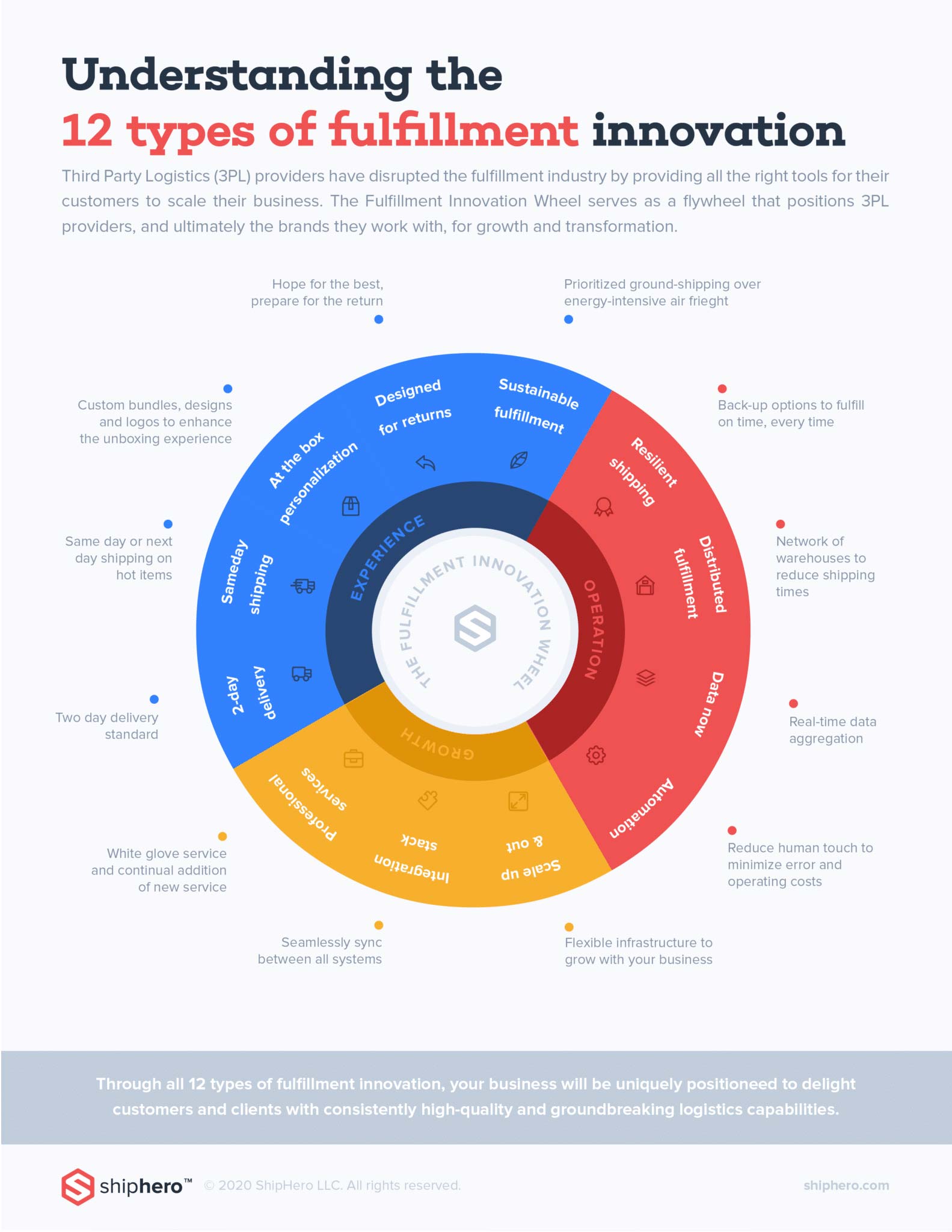
Apr 6, 2021 | Blog, The Fulfillment Innovation Wheel
ShipHero recently launched The Fulfillment Innovation Wheel to help 3PLs understand what capabilities and service offerings they need to implement in order to be successful and to help online retailers and brands choose which 3PL is right for them by allowing them to ‘check the boxes’.
The Fulfillment Innovation Wheel listed a set of twelve (12) capabilities that fulfillment providers and logistics companies should implement to continually delight their customers and push themselves towards greater success and innovation.
The twelve capabilities are:
- 2-Day Delivery
- Same Day Shipping
- At the Box Personalization
- Designed for Returns
- Sustainable Fulfillment
- Resilient Shipping
- Distributed Fulfillment
- Data Now
- Automation
- Scale Up and Out
- Integration Stack
- Professional Services
In this article, we will be diving into Capability #8: Data Now.
And be sure to stay tuned for future articles as we deep-dive into each capability.
Capability #8: Data Now
It’s Your Data, and You Need it Now!
Now that that’s out of the way, let’s talk about the data reporting and insights that will make or break your business. Business operations and logistics enjoys the rather large benefit of being highly calculable, and therefore predictable.
Of course with the infrequent exception, building a resilient and optimized supply chain is made possible through accurate data collection, in-depth analysis and reporting, and intelligent predictions to beat the competition.
In this article, we’ll dive into:
- How to create the right data reports,
- How you can build a robust data pipeline, and
- How to use those insights to make intelligent decisions
Analysis & Reporting
Your warehouse operations can be broken down into four disciplines: Inventory Management, Operations, Shipments, and Production Efficiency.
Inventory Management involves keeping your product in stock, replenishing when you’re out, handling stale inventory and more. Reporting asks how you can do this more efficiently and with less waste.
Operations is the day-to-day functioning of the warehouse, such as getting products safely delivered out of the warehouse (i.e., the pick-pack-ship process); it is also managing errors or mis-picks as well as FEFO/FIFO workflows. Reporting allows you to optimize warehouse capacity.
Shipments is the process of delivering packages from the warehouse to your customers door in the cheapest and most time-effective manner. Reporting helps you see where you spend too much or take too much time.
Production Efficiency is the performance of your employees, if they are adhering to policies, how quickly they can perform their task, etc. Reporting helps you increase productivity and identify rockstars.
Key Performance Indicators
The goal of your reporting should explicitly improve certain aspects within each of the four disciplines, commonly referred to as Key Performance Indicators (KPIs). A KPI is a very specific data point that your business will track and set SMART goals against.
For example, Time to Deliver is a very specific data point that your company can track to see the health of their Shipments processes. By measuring the duration between the product leaving the warehouse and arriving at the customer for each order, you will be able to understand how your business compares to the competition and customer expectations.
You should also set SMART goals for each KPI to continually improve your supply chain. SMART goals are:
- Specific, (e.g., Decrease Time to deliver)
- Measurable, (e.g., by .5 days)
- Attainable, (e.g., don’t set the goal at 8 hours)
- Relevant, (e.g., do your customers care about delivery time?)
- Time-Bound (e.g., by Q1 of 2022)
Understand every element of your warehouse at work by setting KPIs that have tangible benefits to your business, whether it’s reduced costs, increased efficiency, or improved customer experience.
Reference below for a non-exhaustive list of reports that ShipHero typically creates for their customers:
Inventory Management
- Inventory Change Log – Every inventory change is logged. Know what changed, why, when and by whom.
- Inventory Value Report – Review the total quantity and value of your inventory, right now, or by each month.
- Cost of Goods Report – Understand the product profitability across any given date period.
- Inventory Variance Report – Understand the actual quantity amounts of your inventory by any given date period.
- Sales by SKU Report – Quickly view product sales in each of your warehouses, with estimated time to sell based on historical sales velocity.
- Stale Inventory Report – Need to know the slow movers? Quickly identify products that might be sitting around and what to do about it.
Warehouse Operations
- Replenishment Report – Quickly identify inventory bins that are running low or are empty and replenish products.
- Serial Number Report – Individual products can be set to require a serial number log when shipped.
- Lots Report – Track inventory lots and expiration. Manage FEFO & FIFO workflows.
- Packer Error Report – Mistakes happen, no one is perfect. Just… Understand why they’re happening.
Shipments
- Shipments Report – Every shipping label, for every order, showing shipping cost and shipping charges.
- Shipped Items Report – Filter in detail what items have been shipping across orders.
Production Efficiency
- Picker Report – Every pick is logged. Review daily performance, including the number of unique items picked.
- Packer Report – Just as important to picking, know how your shipping team is performing.
Data Collection
Once you set your KPIs and important data points, you must now collect the right information to accurately track progress towards your goals. Many companies use software tools to automatically track and analyze KPI progress, but many startups implement manual counting and calculating on an Excel spreadsheet to yield the same results.
To begin building a robust data pipeline, you should ask the question “what do I need to know?” for each KPI.
In the Time to Deliver example, you need to know when the package was shipped out and when the package was delivered. But for the complete picture, you should also track how much the journey cost, who the carrier was, if there was any delay, etc. to be able to identify root causes of problems and create plans to improve the number going forward.
This may sound simple at first, but as your order complexity and business processes start to grow, finding automated solutions for KPI tracking and optimization is necessary. That’s why many companies turn to ShipHero’s WMS that gives powerful reporting capabilities with a simple click of the button.
Intelligent Decisions
Data analysis and reporting not only tells the current health and progress of your organization, but should also be used to make future-forward and long-term choices. This of course comes with a level of risk, depending on the quality of information.
In the example of Time to Deliver, if you determine that your product deliveries are arriving too late or over-budget, and you want to meet the 2-day delivery standard, then you can use reporting to make better inventory distribution decisions, like relocating inventory to closer warehouses.
Make sure you are getting the right reports into the hand of the right decision-makers so they can make the right choices. Nothing should be left to chance.
Wrap It Up
The amount of reports you can generate is virtually endless, so make sure you are starting with your SMART goals in mind. From there, ask yourself “what do I need to know” for each KPI and start collecting those data points. After the reports and KPIs are tracked, ensure your management team has proper visibility to be able to make intelligent business decisions.
Does your business have the right tools in place to offer affordable and sustainable 2-day delivery? If not, then you may find it hard to compete in the future, especially as more and more people elect for eco-friendly businesses with the same suite of capabilities.
If you’re already working with a fulfillment provider or 3PL, make sure that they’re well-equipped for the task. If not, maybe it’s time for a switch.
Our customers love that ShipHero can offer 2-day ground delivery anywhere in the contiguous United States at simple and transparent pricing. We attribute this success on the Fulfillment Innovation Wheel to Capability #8: Data Now.
Stay tuned next as we cover Capability #2: Same Day Shipping! It’s my data, and I need it now! ShipHero.

Learn more about ShipHero’s industry-leading warehouse management software.

Apr 5, 2021 | Blog
An eCommerce Science Series
In the world of SEO, social media and online sales, the very first step to marketing your eCommerce store is simple: content creation.
From there, you can employ all the tips and tricks of boosting conversion, ranking higher with Adwords, and all that technical jazz, but it all starts with making authentic and engaging content … which also just so happens to be the most difficult to do.
In this blog series, we’ll cover all the ways your e-commerce business can start creating engaging content that tells your brand story and speaks to your audience. To start, we’ll break down one of the best ways for B2B and DTC brands to build trust and engage with your customer base: video!
In the top 100 search result listings, video appears 70% of the time. Not to mention, viewers of your product video are 64-85% more likely to purchase after watching, depending on its quality. So if you aren’t already using video, you’re not being seen.
In this article, we’ll dive into why video is the most effective tool to be seen and to be understood. Then, we’ll explain the various types of videos you can make. Finally, we’ll give you video recording guidelines to make the best possible content.
Ready? Lights, camera, action!
The Benefits of eCommerce Video
We know you’re here for the how-to tips, so let’s keep this brief. Simply put, leveraging video allows your business to:
- Tell your brand story
- Convert viewers to customers
- Develop engagement and community
- Cater to a mobile audience
The facts:
- Average visitor session duration more than triples on product pages that feature videos.
- Customers who watch product videos are nearly twice as likely to complete their online purchase.
- For every one customer that reads a product description, four customers would rather watch a product video.
- Over half of shoppers say that watching product videos makes them more confident about their purchases.
As for mobile:
- According to YouTube (owned by Google), over 70% of watch time is from mobile users, with an average mobile viewing session of 40 minutes.
- Online retailers see nearly 50% of their traffic coming from mobile devices.
The science is out there, and video is the premier way to tell your brand story, convert customers both on desktop and mobile, and increase overall engagement. So what types of videos should you be using on your e-commerce store?
The Five Types of Video Content
There are five primary types of videos you can leverage on your e-commerce store:
- Landing Page video
- Product description videos
- Demonstration videos (demos)
- User-generated or UGC
- Mobile Shopping
Depending on your specific business and audience, try implementing some or all of the below to maximize your engagement.
Landing Page Video
When shoppers land on your website for the first time, whether through a search or ad, they immediately scour the page for what makes your brand unique from all the others. Landing Page videos are the perfect opportunity to tell the story of your brand, allowing you to use strong visuals that are worth a thousand words.
Place the Landing Page video in an easy-to-spot location with an appealing thumbnail. Most companies place the video right next to their icon or slogan for easy clicks.
Product Description Video
Product Description videos are an important tool to convert site visitors to customers. With clear product visuals and well-articulated details, product videos are a great way to grab the attention of your visitors and deliver a complete understanding of what you sell and why.
Place the product videos right underneath product photos, or even consider substituting photos for clickable videos. The primary call-to-action for these videos should be to place items in their online shopping cart.
Product Demonstration Video
If a customer is interested in your product but not completely sold, they will seek out more information. Product Demonstration videos show the customer how your product is used, and how the product can interact with the world around it.
If you have a physical product, show how a customer can interact with or use the product. If it’s a software or digital product, consider screen-recording and walking through real-life use cases.
Product Demonstration videos are typically less “polished” than an advertisement and should feel like an authentic experience. E-commerce brands typically put these on YouTube and include links throughout the shopper journey.
User-Generated Video
Beyond videos produced by your company, some customers still seek a more genuine, authentic opinion. This is where User-Generated Content (UGC) allows your loyal users to share their personal experiences with your product and your brand. You may also know this as Influencer marketing, Ambassadorships, and more social media advertising.
51% of shoppers in the US say they trust UGC more than any other content on a company website, because after watching the videos, they have a better understanding of how the products work in a sincere, real setting.
Modern online retailers add UGC to their webpages to create community, and if you’re an established brand, your users will compete and have pride in appearing on your website (e.g., Nike).
Mobile Shopping Video
Mobile Shopping videos are those optimized videos catered specifically for users watching on a smaller screen, with features built in to click and purchase directly from their mobile device.
With a specific size and aspect ratio for product videos and images, along with predetermined social media channels (e.g., Instagram Shopping), you can provide a holistic mobile-shopping experience.
Wrap It Up
Successful eCommerce retailers are able to reach large audiences with creative, shareable content, and then convert that audience into customers with a well thought out shopper journey.
Video is an important tool in both capturing your audience’s attention and giving them the information they need to make a purchase. With the above information, you are now on your way to telling a better brand story and using powerful visuals to explain your products.
Once you’ve made the sale and the customer has clicked the ‘Order’ button, what comes next? How do you get your product to your customer’s door? And if the customer needs to return your product, how do you handle it? That’s where a 3PL like ShipHero comes in, to help you simplify everything that comes after the ‘Pay Now’ button. Learn more at ShipHero.com.

Apr 2, 2021 | Blog, The Packet
Suez Colonic
After tireless digging and tugging, the mega-ton blockage that has been constipating global trade for the past six days has finally been cleared from the Suez Canal. The global trade community has given a collective sigh of relief as vessels are now starting to pass through.
What Caused This?
Besides a lack of fiber (kidding), a seasonal dust storm, known as the khamsin, blowing winds at 40 knots caused the Ever Given to veer too far right and become embedded in the canal wall. While this is the story for now, navigation experts and engineers at the Suez Canal Authority are investigating the crash for technical and human error — this could have massive insurance implications and lawsuits if a responsible party is identified.
How Did They Get it Out?
A full moon emerged (you can’t make this up) and brought in a high tide that buoyed the engineers efforts to re-float the ship. If this attempt failed, the tide would have fallen and they would have been forced to spend weeks unloading thousands of containers to help the Ever Given sit higher in the water. In total, hundreds of thousands of cubic feet of sand were removed.
The Fallout
Shipping operators estimate $12 billion of cargo is stranded along the 120-mile canal or idling outside it. Other shipping operators have already re-routed ships around the Cape of Good Hope, adding weeks and fuel consumption to the voyage. Experts estimate that this will result in another jam once all the vessels reach their destination at the same time, and over 360 vessels are waiting to pass through the canal. As a result, shipping and oil prices have risen, and the already beleaguered logistics industry will likely face additional delays and costs.
This post has been sponsored by: MiraLAX. Blockage in your canal? MiraLAX.

The American Jobs Plan
Where the American Rescue Plan was Joe Biden’s attempt to bring us out of the pandemic, The American Jobs plan aims to help us the U.S. compete with China and other global powers… but mostly China.
The plan calls for massive investment $2T in infrastructure modernization like highways, railways, hospitals, and more. It also calls for heavy R&D funds for a sustainable and secure supply chain, with large quantities of funding directed towards emerging technologies and their role in the supply chain.
The Future
Boston Dynamics has introduced a new robot prototype, named Stretch, designed to pick-and-pack boxes around warehouses and distribution centers.
Stretch can move up to 800 cases per hour, picking up boxes around 50 pounds. It can adapt to any facility layout change, and it’s battery lasts around an entire shift (and can run continuously when plugged in.) The robot is battery-powered with a charge that should last through an entire shift. It can also run continuously when plugged in.
Just Sue It
Nike has filed a trademark infringement lawsuit against a small marketing company, MSCHF Product Studio Inc, that released 666 pairs of Satan-themed sneakers in collaboration with Lil Nas X to promote the rapper’s new song (spoiler alert: in the video he gives a lap dance to the devil) at a price tag of $1,018 each. Nike has publicly announced the shoes were made without their approval or authorization.
This comes at a time where Nike is experiencing large-scale boycotts in China, for statements Nike (and H&M) made about China’s use of forced labor to supply XinJiang cotton.
ShipHero News
The Fulfillment Innovation Wheel: 2-day Delivery
Staying competitive in today’s e-commerce landscape is easy! From the moment when the customer clicks ‘Order’, you just need to be prepared to cover potentially hundreds of miles to deliver your products to their doorstep… in under 48 hours. Tick-tock! Learn more with ShipHero’s Fulfillment Innovation Wheel series: 2-day Delivery.




